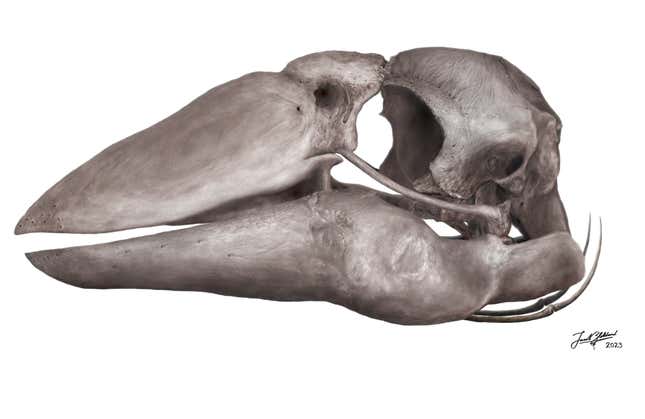An Ice Age bird that weighed twice as much as an ostrich was adapted for the water, say a team of researchers who recently studied fossils from creature, which went extinct about 45,000 years ago. Based on bones of Genyornis newtoni found in South Australia’s Lake Callabonna, the animal weighed about 500 pounds (230 kilograms), making it five times as heavy as the fearsome southern cassowary. The recent trove of remains, including a nearly foot-long skull, was found in 2019.
The only other known skull of Genyornis was found in 1913, and it was heavily damaged. 128 years later, the new fossils—and new technology—allowed a research team to make more detailed conclusions about the life and times of this giant bird. Their research is published today in Historical Biology.
Lake Callabonna is “a bit of a megafauna necropolis,” said Jacob Blokland, a paleontologist at Flinders University and a co-author of the paper, in an email to Gizmodo. “This site has been on record since the late 1800s, but has likely been part of indigenous knowledge for far far longer.”
“At this time Genyornis was thought to be a ‘struthious bird’, more related to cassowaries and emus, so subsequent reconstructions were influenced by such,” Blokland added.
The team’s research has shaken up those conclusions. The bird’s upper jaw was tall like a parrot’s but shaped like a goose’s (hence its ‘giga-goose’ nickname, as dubbed in a Taylor & Francis release). It had a large braincase and a casque, an enlargement of the bone on the top of its head. Though the animal was compared to large birds due to its size, the recent work finds the animal was morphologically similar to modern waterfowl like the South American screamers.
“The new skull material for this Genyornis has revealed a goose-like bill and several specialist features of the skull that are related to the bird submerging its skull in the water. This bird must have foraged in the water at least some of the time, perhaps eating soft aquatic weeds or new plant shoots. It also has hindlimb adaptations for traveling across hard ground, and might have travelled from lake to lake, eating fruits and the like along the way.”
Genyornis went extinct about 45,000 years ago, meaning it shared Earth with anatomically modern humans and even Neanderthals (though the latter were not in Australia). There’s no archaeological or anthropological evidence that humans and Genyornis interacted, though they did inhabit the same area at the same time.

“We cannot for certain say why Genyornis went extinct because it’s likely a complex interaction of multiple variables,” said Phoebe McInerney, a paleontologist at Flinders University in a Australia and the study’s lead author, in an email to Gizmodo. “However, with the skull showing these birds to have adaptations for being in and around water, this suggests that they lived and relied on semi-aquatic environments.”
“During the time Genyornis was alive, the inland lakes of South Australia were experiencing drought phases and were slowly transitioning to the salty and dry state they are in today,” McInerney added. “This would have likely contributed to Genyornis becoming locally extinct in this region.”
While the cause of its disappearance remains uncertain, the bird’s morphology and its ecological niche are now much clearer. More fossils may continue to develop paleontologists’ understanding of this gigantic goose-like forager.
More: Fossil Reveals ‘Wonderchicken,’ the Earliest Known Modern Bird

Dr. Sarah Adams is a scientist and science communicator who makes complex topics accessible to all. Her articles explore breakthroughs in various scientific disciplines, from space exploration to cutting-edge research.







